Sidelobes Suppression for Time Domain Anti-Jamming of Satellite Navigation Receivers
Abstract
1. Introduction
2. Mathematical Model
2.1. Signal Model
2.2. Time-Domain Anti-Jamming Model
3. Mechanism Analysis of Sidelobes Lift
4. Sidelobes Suppression Technology
4.1. Correlation Peak Model
4.2. Sidelobes Suppression
- (1)
- According to the frequency grid division, multiply the anti-jamming digital intermediate frequency signal by the frequency carrier to complete the mixing.
- (2)
- Perform N-point Fast Fourier Transform (FFT) on the mixed signal (if the number of points is less than N, it needs to be filled with zeros).
- (3)
- Perform complex conjugate processing on the FFT transformation result of the locally copied pseudocode, and multiply it with the FFT transformation of the mixing output signal.
- (4)
- Perform Inverse Fast Fourier Transform (IFFT) on the result of step (3) to obtain the cross-correlation result between the received signal and the local spread spectrum signal.
- (5)
- Perform absolute value judgment on the result of (4). If it exceeds the threshold, it is considered that the acquisition is successful, and the code phase and frequency estimation value are outputted, otherwise steps (3), (4), and (5) are repeated, and the new frequency is searched until the search is complete.
5. Simulation Experiment
5.1. Effect of Reconstruction Number on Sidelobes Suppression
5.2. Effect of Interference Bandwidth on Sidelobes Suppression
5.3. Effect of Amplitude Estimation Accuracy
6. Discussion
7. Conclusions
Author Contributions
Funding
Acknowledgments
Conflicts of Interest
References
- Ladina, S.; Michael, M.; Christoph, M. Impact of GPS processing on the estimation of snow water equivalent using refracted GPS signals. IEEE Trans. Geosci. Remote Sens. 2020, 58, 123–135. [Google Scholar]
- Camps, A. Spatial Resolution in GNSS-R Under Coherent Scattering. IEEE Geosci. Remote Sens. Lett. 2020, 17, 32. [Google Scholar] [CrossRef]
- Zhang, P.; Tu, R.; Zhang, R.; Gao, Y.; Cai, H. Combining GPS, BeiDou, and Galileo Satellite Systems for Time and Frequency Transfer Based on Carrier Phase Observations. Remote Sens. 2018, 10, 324. [Google Scholar] [CrossRef]
- Chen, H.; Niu, F.; Su, X.; Gegn, T.; Liu, Z.; Li, Q. Initial Results of Modeling and Improvement of BDS-2/GPS Broadcast Ephemeris Satellite Orbit Based on BP and PSO-BP Neural Networks. Remote Sens. 2021, 13, 4801. [Google Scholar] [CrossRef]
- Yi, T.-H.; Li, H.-N.; Gu, M. Experimental assessment of high-rate GPS receivers for deformation monitoring of bridge. Measurement 2013, 46, 420. [Google Scholar] [CrossRef]
- Chertova, O.G.; Chirov, D.S. Development Prospects of the ERA-GLONASS System. In Proceedings of the 2022 Wave Electronics and Its Application in Information and Telecommunication Systems (WECONF), St-Petersburg, Russia, 30 May 2022. [Google Scholar] [CrossRef]
- Elghamrawy, H.; Karaim, M.; Korenberg, M.; Noureldin, A. High-Resolution Spectral Estimation for Continuous Wave Jamming Mitigation of GNSS Signals in Autonomous Vehicles. IEEE Trans. Intell. Transp. Syst. 2022, 23, 7881–7895. [Google Scholar] [CrossRef]
- Rezazadeh, N.; Shafai, L. A Compact Antenna for GPS Anti-Jamming in Airborne Applications. IEEE Access 2019, 7, 154253–154259. [Google Scholar] [CrossRef]
- Liu, Y.; Zhang, S.; Gao, Y. A High-Temperature Stable Antenna Array for the Satellite Navigation System. IEEE Antennas Wirel. Propag. Lett. 2017, 16, 1397–1400. [Google Scholar] [CrossRef]
- Lu, Z.; Chen, F.; Xie, Y.; Sun, Y.; Cai, H. High Precision Pseudo-Range Measurement in GNSS Anti-jamming Antenna Array Processing. Electronics 2020, 9, 412. [Google Scholar] [CrossRef]
- Chien, Y.-R. Design of GPS Anti-Jamming Systems Using Adaptive Notch Filters. IEEE Syst. J. 2015, 9, 451–460. [Google Scholar] [CrossRef]
- Chaparro, D.; AFeldman, F.; Chaubell, M.J.; Yueh, S.H.; Entekhabi, D. Robustness of Vegetation Optical Depth Retrievals Based on L-Band Global Radiometry. IEEE Trans. Geosci. Remote Sens. 2022, 60, 4413417. [Google Scholar] [CrossRef]
- Xu, W.; Xing, W.; Fang, C.; Huang, P.; Tan, W.; Gao, Z. RFI Suppression for SAR Systems Based on Removed Spectrum Iterative Adaptive Approach. Remote Sens. 2020, 12, 3520. [Google Scholar] [CrossRef]
- Marathe, T.; Daneshmand, S.; Lachapelle, G. Assessment of Measurement Distortions in GNSS Antenna Array Space-Time Processing. Int. J. Antennas Propag. 2016, 2, 1–17. [Google Scholar] [CrossRef]
- Lu, Z.; Chen, H.; Chen, F.; Nie, J.; Ou, G. Blind Adaptive Channel Mismatch Equalization Method for GNSS Antenna Arrays. IET Radar Sonar Navig. 2018, 12, 383–389. [Google Scholar] [CrossRef]
- Zhou, Q.; Zheng, H.; Wu, X.; Yue, X.; Chen, Z.; Wang, Q. Fractional Fourier Transform-Based Radio Frequency Interference Suppression for High-Frequency Surface Wave Radar. Remote Sens. 2020, 12, 75. [Google Scholar] [CrossRef]
- Gao, G.X.; Sgammini, M.; Lu, M.; Kubo, N. Protecting GNSS Receivers From Jamming and Interference. Proc. IEEE 2016, 104, 1327–1338. [Google Scholar] [CrossRef]
- Song, J.; Lu, Z.; Xiao, Z.; Li, B.; Sun, G. Optimal Order of Time-Domain Adaptive Filter for Anti-jamming Navigation Receiver. Remote Sens. 2022, 14, 48. [Google Scholar] [CrossRef]
- Bertold, V.D.B.; Sofie, P. Keeping UAVs under control during GPS jamming. IEEE Syst. J. 2019, 13, 2010–2021. [Google Scholar]
- Lu, Z.; Nie, J.; Chen, F.; Ou, G. Impact on Anti-jamming Performance of Channel Mismatch in GNSS Antenna Arrays Receivers. Int. J. Antennas Propag. 2016, 2016, 1909708. [Google Scholar] [CrossRef]
- Kim, S.; Park, K.; Seo, J. Mitigation of GPS Chirp Jammer Using a Transversal FIR Filter and LMS Algorithm. In Proceedings of the 34th International Technical Conference on Circuits/Systems, Computers and Communications (ITC-CSCC), JeJu, Korea, 23–26 June 2019. [Google Scholar] [CrossRef]
- Nouri, M.; Aghdam, S.A.; Vakili, V.T. An optimal method for narrowband interference mitigation in the GPS. In Proceedings of the Fourth International Conference on Modeling, Simulation and Applied Optimization, Kuala Lumpur, Malaysia, 19–21 April 2011. [Google Scholar] [CrossRef]
- Cheng, L.; Wang, K.; Ren, M.; Yan, G. Adaptive Filter Approach for GPS Multipath Estimation Under Correntropy Criterion in Dynamic Multipath Environment. IEEE Trans. Signal Process. 2019, 67, 5798–5810. [Google Scholar] [CrossRef]
- Lu, Z.; Nie, J.; Wan, Y.; Ou, G. Optimal reference element for interference suppression in GNSS antenna arrays under channel mismatch. IET Radar Sonar Navig. 2017, 11, 1161–1169. [Google Scholar] [CrossRef]
- Compton, R.T. The power-inversion adaptive array: Concept and performance. IEEE Trans. Aerosp. Electron. Syst. 1979, 15, 803–814. [Google Scholar] [CrossRef]
- Jie, W.; Liu, W.; Chen, F.; Lu, Z.; Gang, O. GNSS array receiver faced with overloaded interferences: Anti-jamming performance and the incident directions of interferences. J. Syst. Eng. Electron. 2022, 99, 1–7. [Google Scholar] [CrossRef]
- Lu, Z.; Nie, J.; Chen, F.; Chen, H.; Ou, G. Adaptive Time Taps of STAP Under Channel Mismatch for GNSS Antenna Arrays. IEEE Trans. Instrum. Meas. 2017, 66, 2813–2824. [Google Scholar] [CrossRef]
- Lu, Z.; Song, J.; Huang, L.; Ren, C.; Xiao, Z.; Li, B. Distortionless 1/2 Overlap Windowing in Frequency Domain Anti-Jamming of Satellite Navigation Receivers. Remote Sens. 2022, 14, 1801. [Google Scholar] [CrossRef]
- Fan, G. Research on High Precision Ranging Technology of Anti-Jamming Receiver under Non-Ideal Channel. Doctoral Dissertation, National University of Defense Technology, Changsha, China, 2016. [Google Scholar]
- Zhou, Z.; Wei, Y. The Influence of Automatic Gain Control on Narrowband Frequency Domain GPS Anti-Jamming Receiver. In Proceedings of the IEEE 21st International Conference on Communication Technology (ICCT), Tianjin, China, 13–16 October 2021. [Google Scholar] [CrossRef]
- Li, X.; Chen, F.; Lu, Z.; Liu, Z.; Ou, G. Overview of Anti-Jamming Technology Based on GNSS Single-Antenna Receiver. In Proceedings of the 3rd International Conference on Geoinformatics and Data Analysis (ICGDA), Marseille, France, 15–17 April 2020. [Google Scholar] [CrossRef]
- Zhang, T.; Zhao, H.; Cui, X.; Lu, M. The Upper Bound of Anti-Jamming Capability for GNSS Receivers with Finite Quantization Bits. In Proceedings of the China Satellite Navigation Conference (CSNC), Beijing, China, 22–25 May 2012. [Google Scholar] [CrossRef]
- Blinchikoff, H.J. Range sidelobe reduction for the quadriphase codes. IEEE Trans. Aerosp. Electron. Syst. 1996, 32, 668–675. [Google Scholar] [CrossRef]
- Li, Z. Research on Anti-Jamming Technology of Satellite Positioning Receiver. Ph.D. Thesis, National University of Defense Technology, Changsha, China, 2004. [Google Scholar]
- Xue, B.; Gai, M.; Shen, F.; Liu, N. A novel method of multipath mitigation for C/A code tracking loop based on wavelet transform. In Proceedings of the IEEE International Conference on Information and Automation, Shenzhen, China, 6–8 June 2011. [Google Scholar] [CrossRef]
- Gao, Y.; Xie, S. A variable step size LMS adaptive filtering algorithm and analysis. Chin. Electron. J. 2001, 29, 1094–1097. [Google Scholar]
- Liu, Y.-J.; Hu, H.-Y. The Research on GPS Frequency Domain Anti-Jamming Algorithms. In Proceedings of the 5th International Conference on Wireless Communications, Networking and Mobile Computing, Beijing, China, 24 September 2009. [Google Scholar] [CrossRef]
- Cui, J.; Chen, N.; He, P. Adaptive anti jamming algorithm for GNSS software receiver. In Proceedings of the IEEE Information Technology, Networking, Electronic and Automation Control Conference, Chongqing, China, 20–22 May 2016. [Google Scholar] [CrossRef]
- Savas, C.; Falco, G.; Dovis, F. A Comparative Performance Analysis of GPS L1 C/A, L5 Acquisition and Tracking Stages Under Polar and Equatorial Scintillations. IEEE Trans. Aerosp. Electron. Systems. 2021, 57, 227–244. [Google Scholar] [CrossRef]
- Schmidt, E.; Gatsis, N.; Akopian, D. A GPS Spoofing Detection and Classification Correlator-Based Technique Using the LASSO. IEEE Trans. Aerosp. Electron. Syst. 2020, 56, 4224–4237. [Google Scholar] [CrossRef]
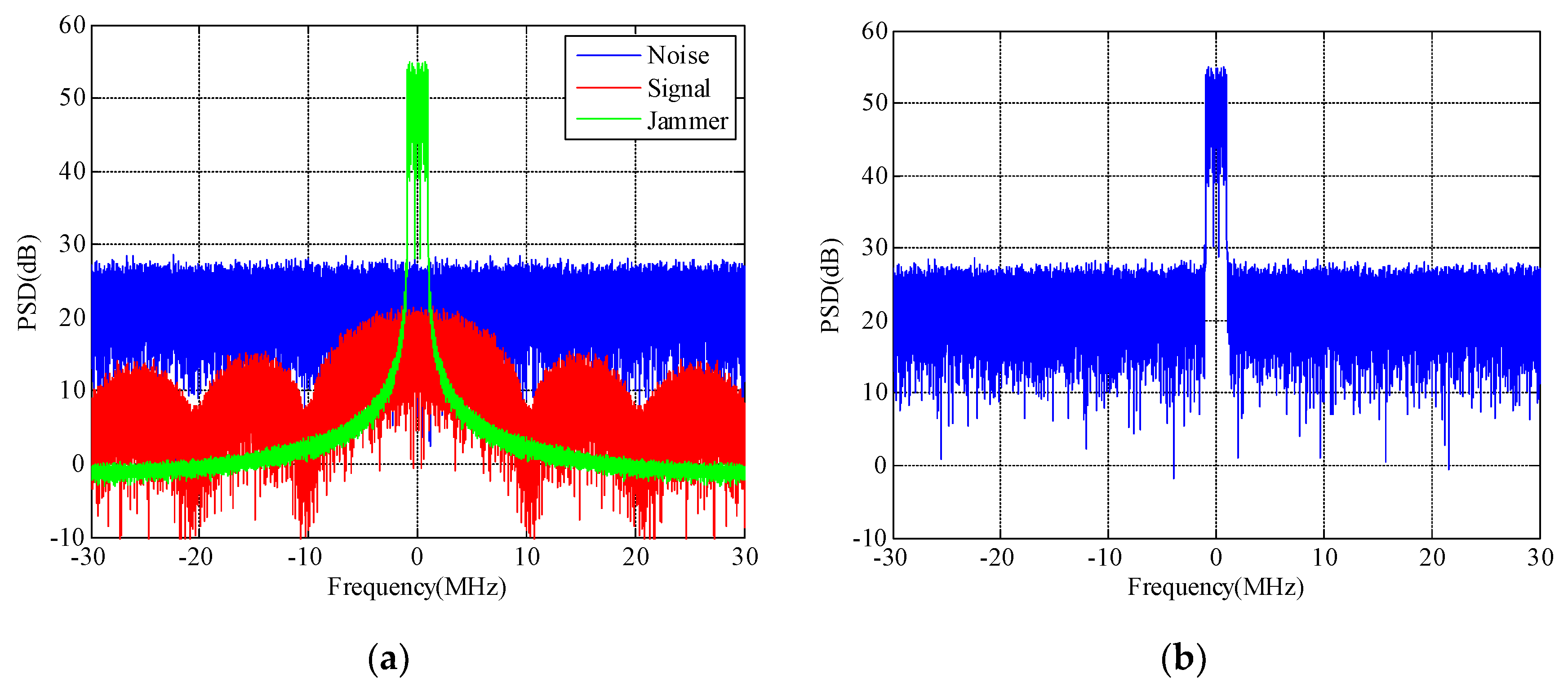
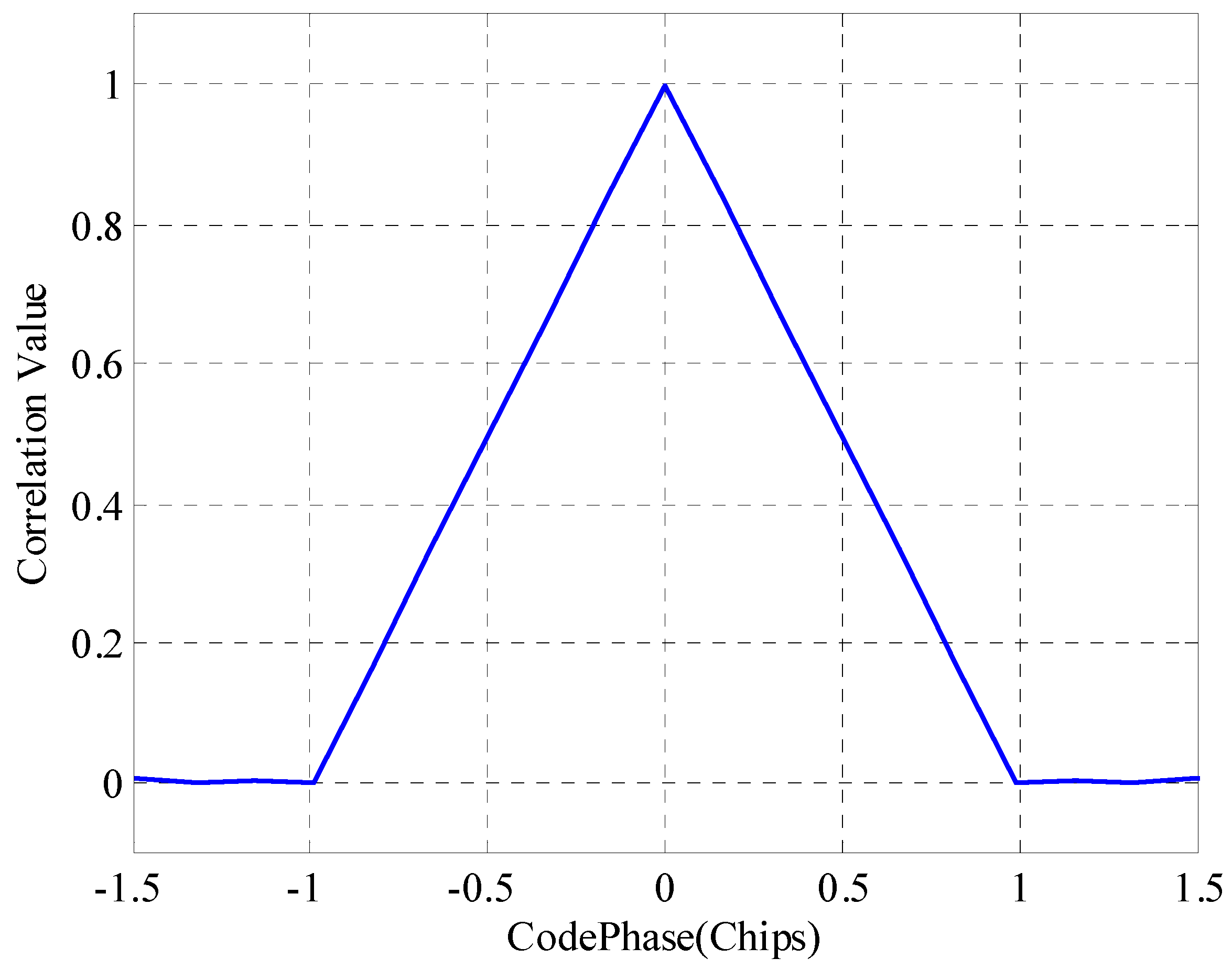

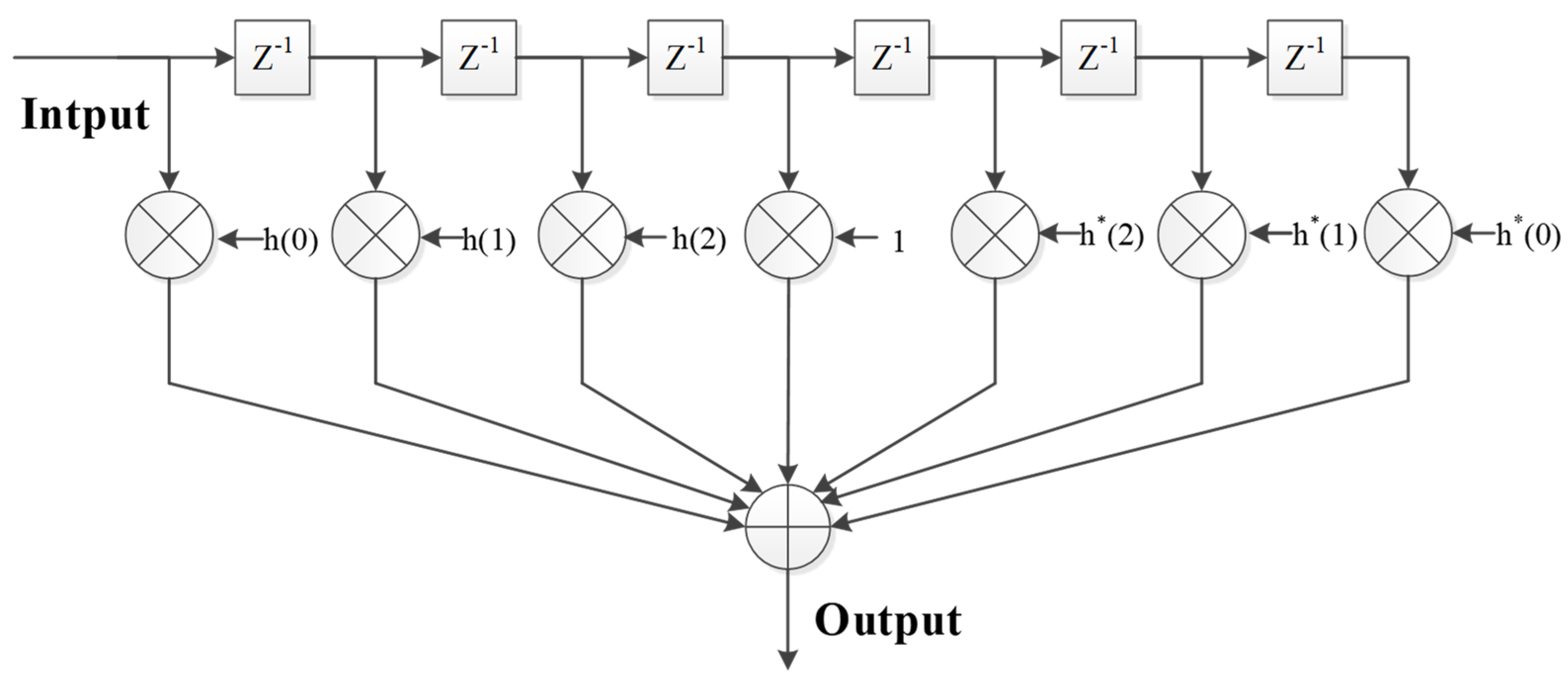



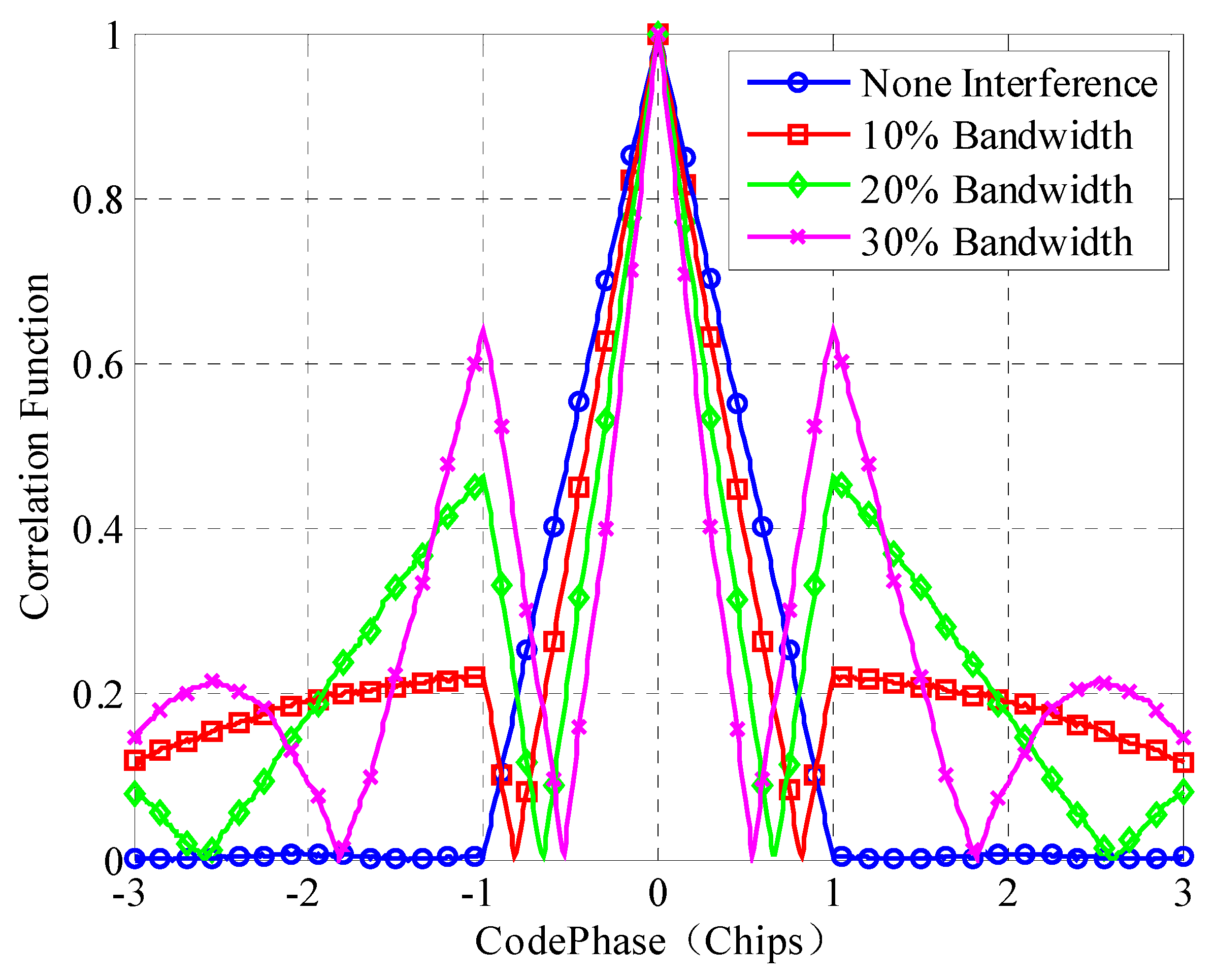
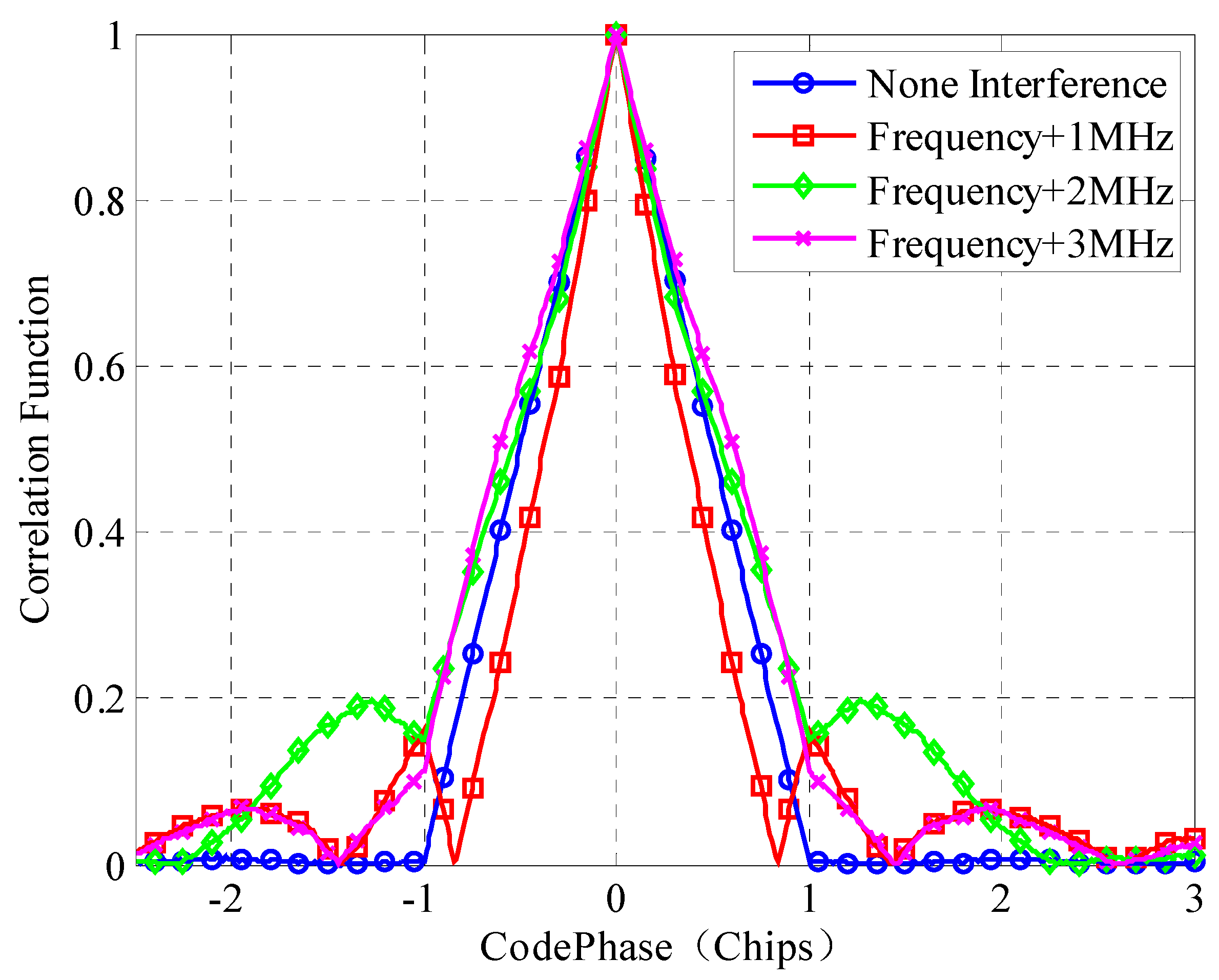


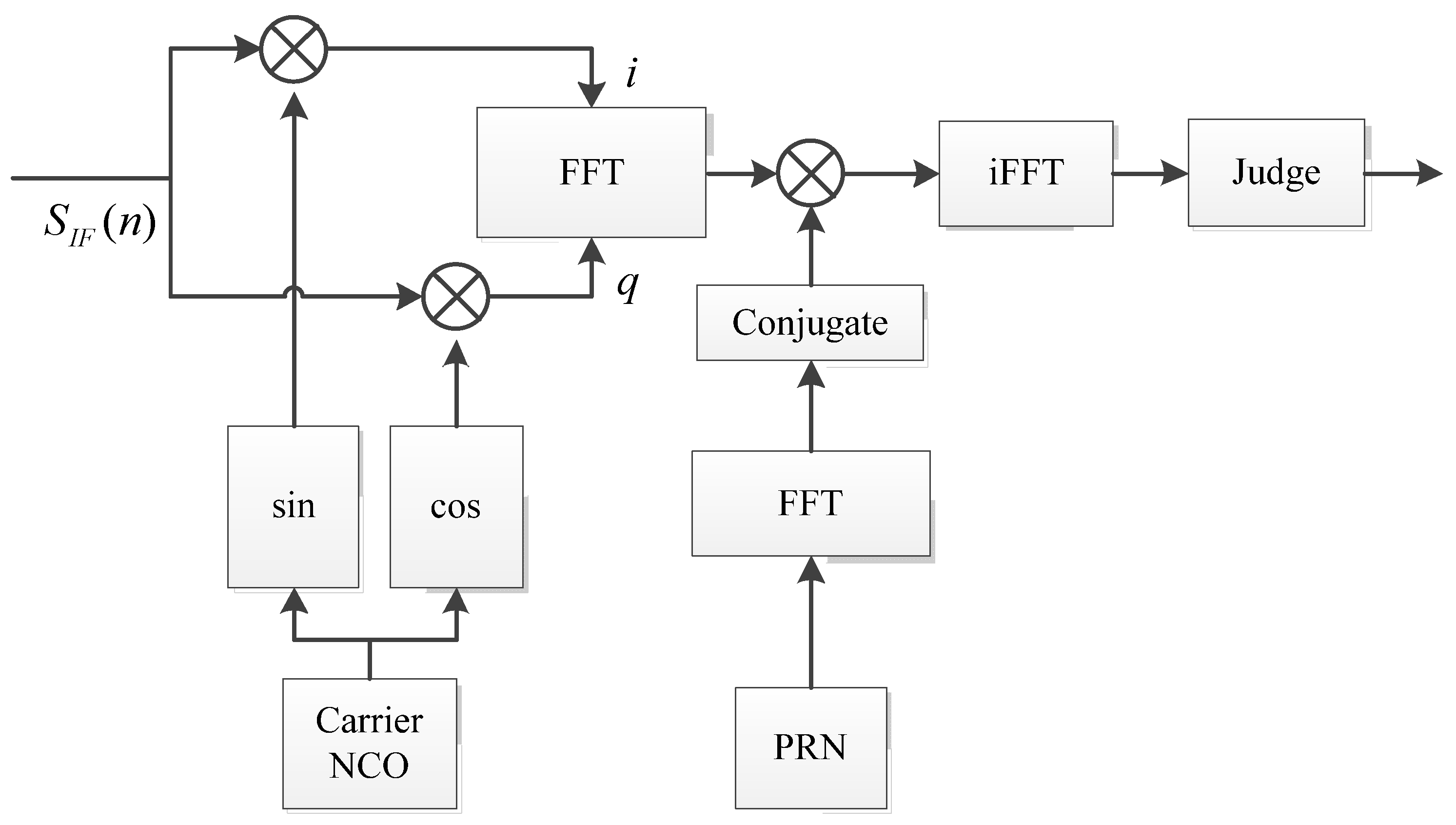


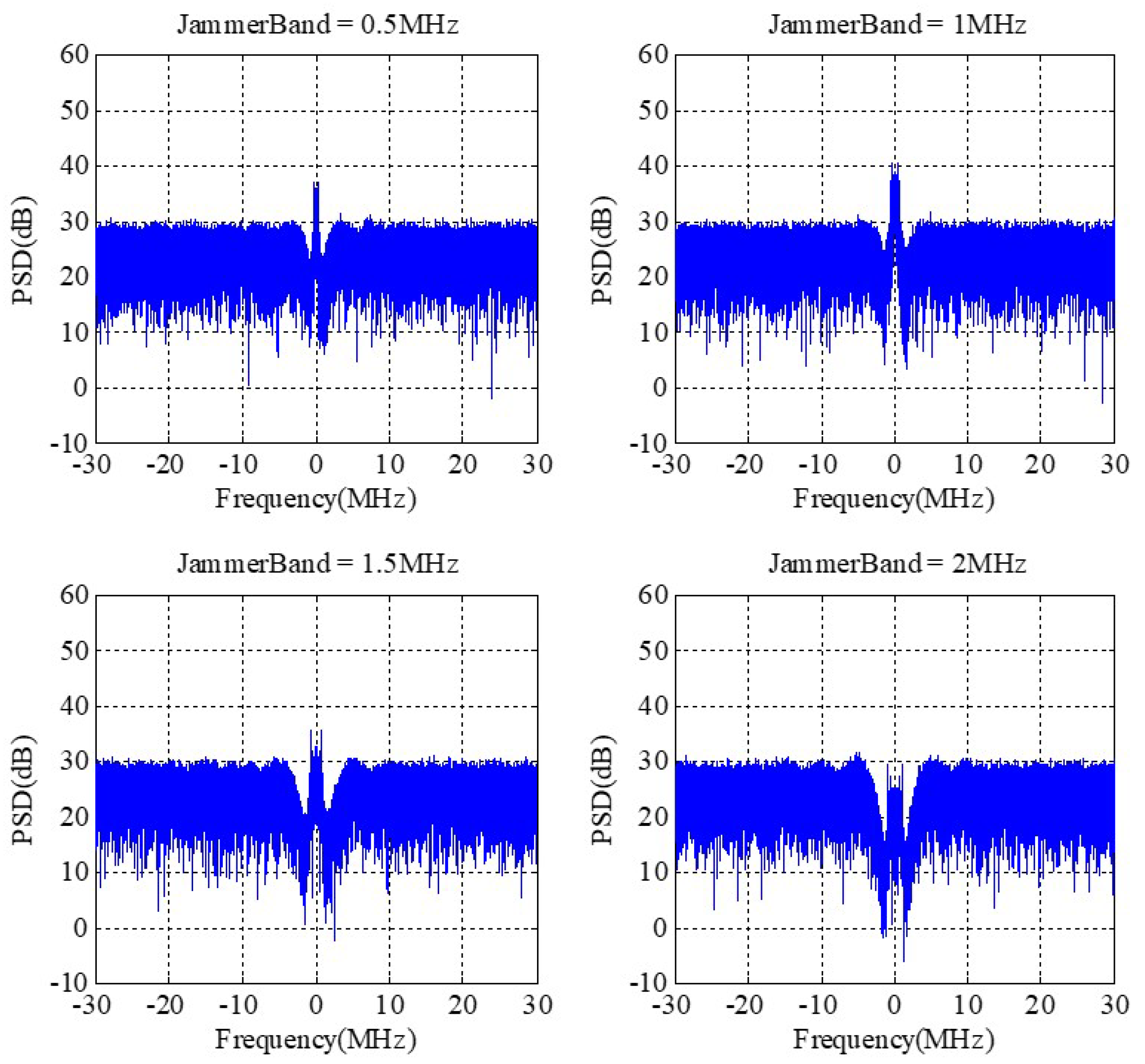
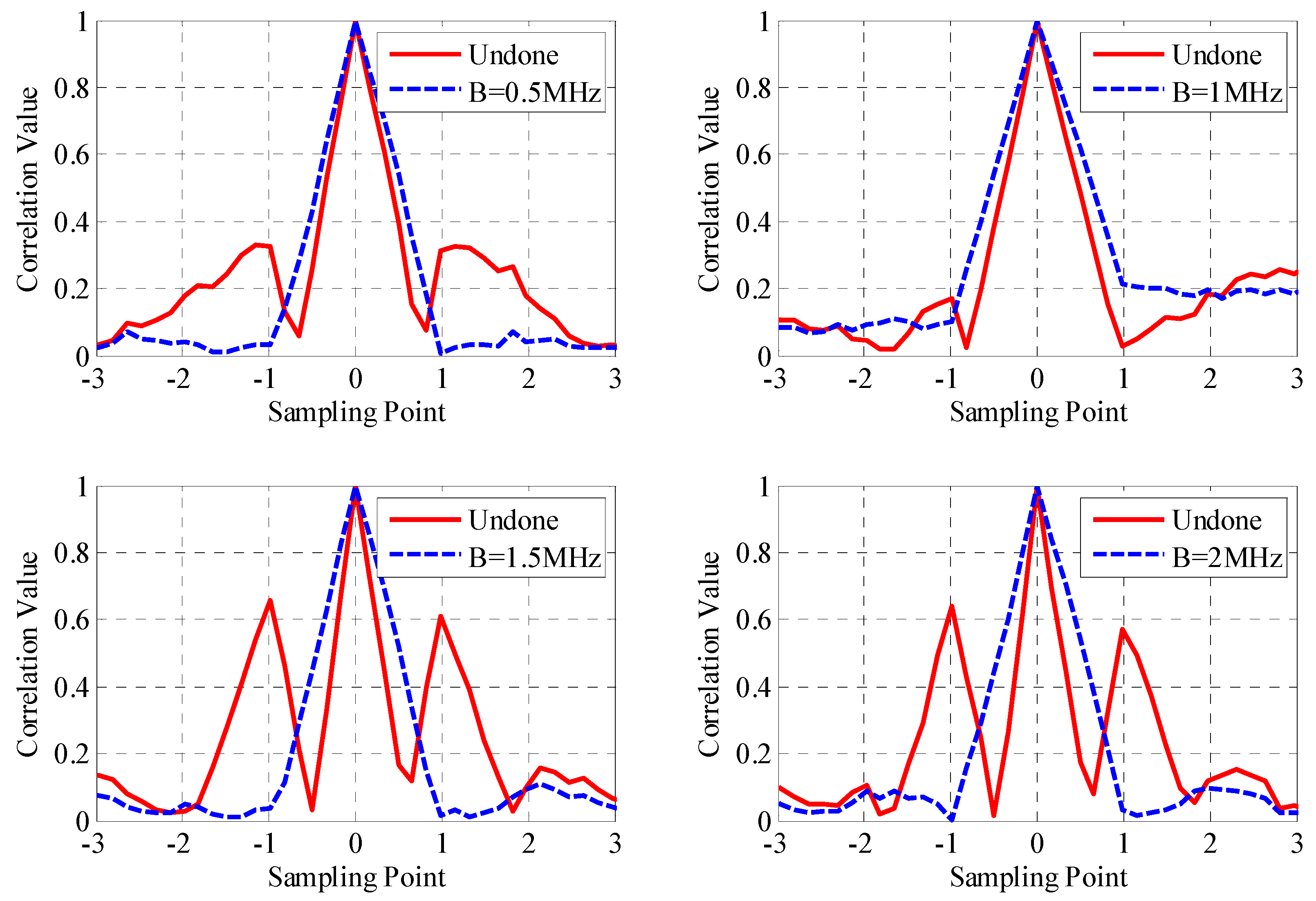
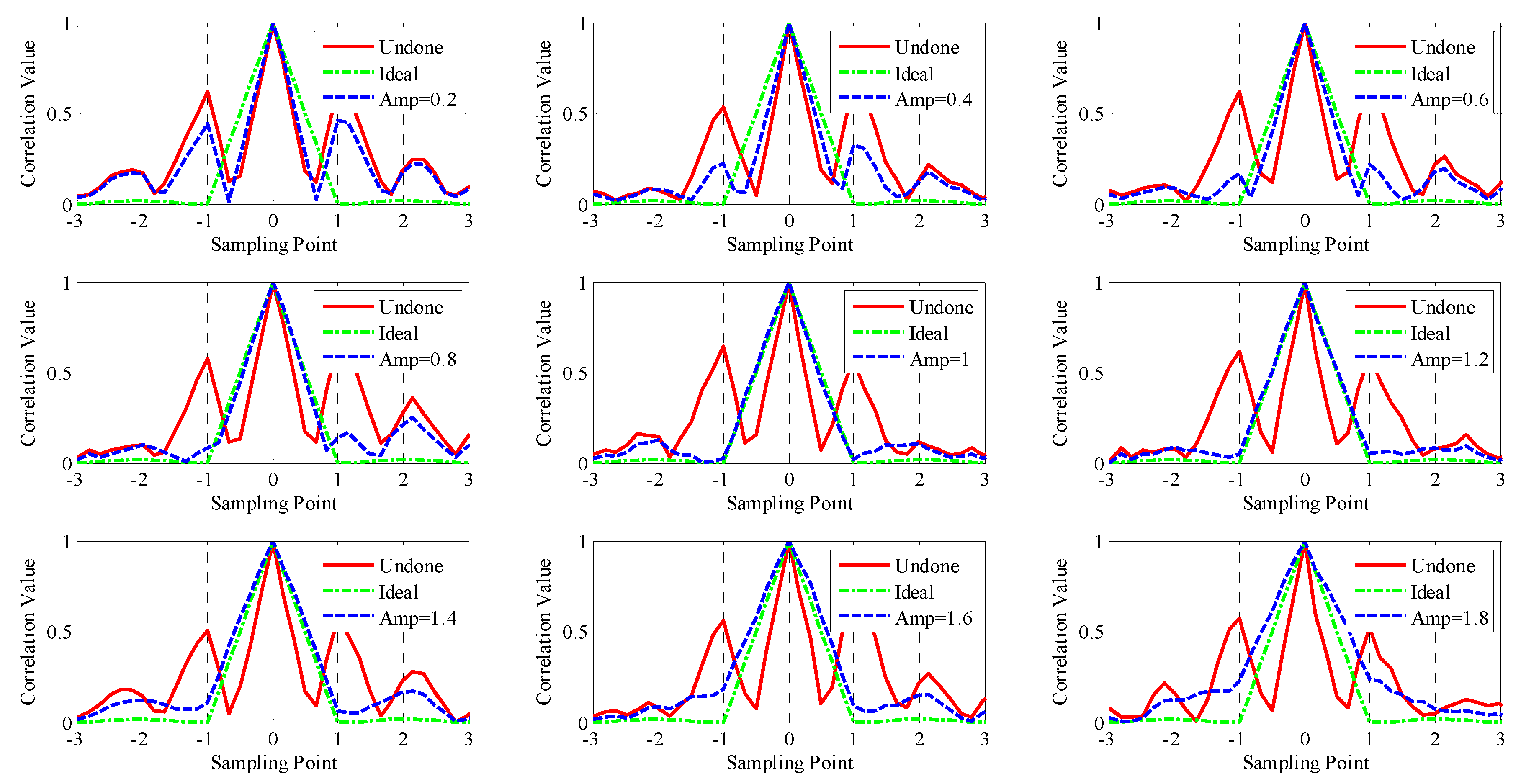
Publisher’s Note: MDPI stays neutral with regard to jurisdictional claims in published maps and institutional affiliations. |
© 2022 by the authors. Licensee MDPI, Basel, Switzerland. This article is an open access article distributed under the terms and conditions of the Creative Commons Attribution (CC BY) license (https://creativecommons.org/licenses/by/4.0/).
Share and Cite
Liu, W.; Lu, Z.; Wang, Z.; Li, X.; Li, Z.; Xiao, W.; Ye, X.; Wang, Z.; Song, J.; Qiao, J.; et al. Sidelobes Suppression for Time Domain Anti-Jamming of Satellite Navigation Receivers. Remote Sens. 2022, 14, 5609. https://doi.org/10.3390/rs14215609
Liu W, Lu Z, Wang Z, Li X, Li Z, Xiao W, Ye X, Wang Z, Song J, Qiao J, et al. Sidelobes Suppression for Time Domain Anti-Jamming of Satellite Navigation Receivers. Remote Sensing. 2022; 14(21):5609. https://doi.org/10.3390/rs14215609
Chicago/Turabian StyleLiu, Wenxiang, Zukun Lu, Zhiying Wang, Xianghao Li, Zongnan Li, Wei Xiao, Xiaozhou Ye, Zhi Wang, Jie Song, Jia Qiao, and et al. 2022. "Sidelobes Suppression for Time Domain Anti-Jamming of Satellite Navigation Receivers" Remote Sensing 14, no. 21: 5609. https://doi.org/10.3390/rs14215609
APA StyleLiu, W., Lu, Z., Wang, Z., Li, X., Li, Z., Xiao, W., Ye, X., Wang, Z., Song, J., Qiao, J., & Li, B. (2022). Sidelobes Suppression for Time Domain Anti-Jamming of Satellite Navigation Receivers. Remote Sensing, 14(21), 5609. https://doi.org/10.3390/rs14215609





